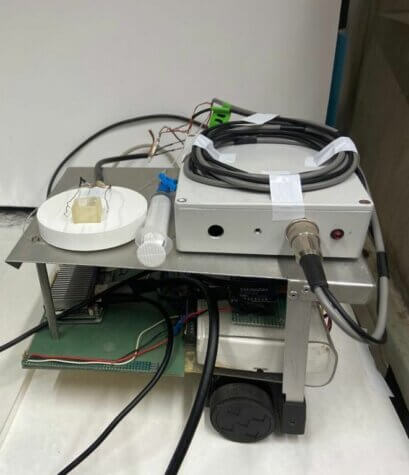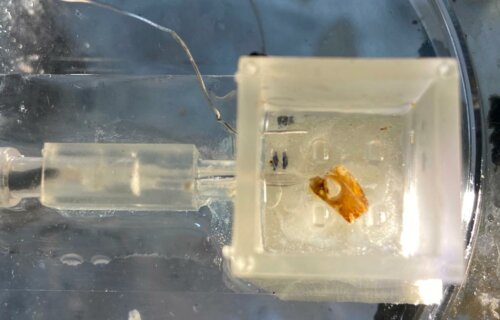
TEL AVIV — The ear of a locust has been transplanted inside a robot, making the machine capable of receiving signals and hearing. This groundbreaking development published in 2021 was unprecedented for scientists, taking robotics to a fascinating new level.
Researchers from Tel Aviv University in Israel demonstrated the robot’s hearing abilities by clapping. One clap signals the robot to move forward and two claps signal the robot to back up. The goal of the study was to demonstrate the effect of biological parts in technological systems.
“We chose the sense of hearing because it can be easily compared to existing technologies, in contrast to the sense of smell, for example, where the challenge is much greater,” says Dr. Ben M. Maoz, a professor with the university’s school of engineering, in a statement. Maoz worked with Prof. Yossi Yovel and Prof. Amir Ayali, experts from the School of Zoology and the Sagol School of Neuroscience, together with Dr. Anton Sheinin, Idan Fishel, Yoni Amit, and Neta Shavil.
“Our task was to replace the robot’s electronic microphone with a dead insect’s ear, use the ear’s ability to detect the electrical signals from the environment, in this case, vibrations in the air, and, using a special chip, convert the insect input to that of the robot,” says Maoz.
The first step was to create a robot that could receive sensory input from the environment. Next, researchers sought to dissect the ear of the locust and keep it functional to integrate into the robot. The final step included the production of signals that could be picked up by the robot so the team would know if vibrations were successfully heard.
“Professor Ayali’s laboratory has extensive experience working with locusts, and they have developed the skills to isolate and characterize the ear. Professor Yovel’s laboratory built the robot and developed code that enables the robot to respond to electrical auditory signals. My laboratory has developed a special device – Ear-on-a-Chip – that allows the ear to be kept alive throughout the experiment by supplying oxygen and food to the organ while allowing the electrical signals to be taken out of the locust’s ear and amplified and transmitted to the robot,” explains Maoz.

“In general, biological systems have a huge advantage over technological systems – both in terms of sensitivity and in terms of energy consumption. This initiative of Tel Aviv University researchers opens the door to sensory integrations between robots and insects – and may make much more cumbersome and expensive developments in the field of robotics redundant,” adds Dr. Maoz. “It should be understood that biological systems expend negligible energy compared to electronic systems. They are miniature, and therefore also extremely economical and efficient. For the sake of comparison, a laptop consumes about 100 watts per hour, while the human brain consumes about 20 watts a day.
“Nature is much more advanced than we are, so we should use it. The principle we have demonstrated can be used and applied to other senses, such as smell, sight, and touch,” Maoz continues. “For example, some animals have amazing abilities to detect explosives or drugs; the creation of a robot with a biological nose could help us preserve human life and identify criminals in a way that is not possible today. Some animals know how to detect diseases. Others can sense earthquakes. The sky’s the limit.”
The results of the study are published in the journal Sensors.

Did it like what it heard? Would it tell us if it did?